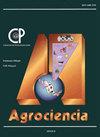开曼草的刈割频率对墨西哥湿热带热力的影响
IF 0.5
4区 农林科学
Q4 AGRICULTURE, MULTIDISCIPLINARY
引用次数: 0
摘要
研究了开曼草(Urochloa HYBRID)刈割频率对其生物量、水分、灰分、萃取物、中性洗涤纤维(FDN)、酸性洗涤纤维(FDA)、酸性洗涤木质素(LDA)、粗蛋白质(PC)、发热量和理论生物乙醇产量的影响。建立4个切割频率作为处理:30d、60d、90d和120d,采用完全随机区组设计,3个重复。数据采用GLM (SAS)分析,均数采用Tukey检验比较(p≤0.05)。当切割频率为120 d时,生物量产量最高(11.9 Mg ha-1年-1),热值最高(15.1 MJ kg-1), LDA最高(5.7%)。切割频率为90d时,FDN(61.8%)、FDA(43.6%)、纤维素(38.1%)和理论生物乙醇产量(218.4 L Mg-1 MS)的浓度有统计学差异。7%)和空灵提取物(1.8%)在60 d切割频率下有统计学差异;而PC(9.7%)和灰分(11.8%)在30d切割频率上差异显著。根据开曼草的生物质产量和热值,它可以被认为是一种潜在的纤维素乙醇生产植物材料。本文章由计算机程序翻译,如有差异,请以英文原文为准。
CUTTING FREQUENCY IN CAYMAN GRASS (Urochloa HYBRID) ON THE CALORIFIC POWER OF THE MEXICAN WET TROPIC
The objective of this study was to evaluate the effect of cutting frequency in Cayman grass (Urochloa HYBRID) on biomass yield, moisture, ash, ethereal extract, neutral detergent fiber (FDN), acid detergent fiber (FDA), acid detergent lignin (LDA), crude protein (PC), calorific value, and theoretical bioethanol yield. Four cutting frequencies were established as treatments: 30, 60, 90, and 120 d, arranged in a completely randomized block design with three replications. Data were analyzed with GLM (SAS), and means were compared with the Tukey test (p ≤ 0.05). The highest biomass production (11.9 Mg ha-1 year-1), calorific value (15.1 MJ kg-1), and LDA (5.7 %) were obtained at the 120 d cutting frequency. The concentration of FDN (61.8 %), FDA (43.6 %), cellulose (38.1 %), and theoretical bioethanol production (218.4 L Mg-1 MS) were statistically different at the cutting frequency of 90 d. The values of hemicellulose (18. 7 %) and ethereal extract (1.8 %) were statistically different at the 60 d-cutting frequency; while PC (9.7 %) and ash (11.8 %) showed significant differences at the 30-d cutting frequency. Based on the biomass yield and calorific value of Cayman grass, it can be considered as a potential plant material for cellulosic ethanol production.
求助全文
通过发布文献求助,成功后即可免费获取论文全文。
去求助
来源期刊

Agrociencia
农林科学-农业综合
CiteScore
0.50
自引率
33.30%
发文量
51
审稿时长
18-36 weeks
期刊介绍:
AGROCIENCIA is a scientific journal created and sponsored by the Colegio de Postgraduados. Its main objective is the publication and diffusion of agricultural, animal and forestry sciences research results from mexican and foreign scientists. All contributions are peer reviewed. Starting in the year 2000, AGROCIENCIA became a bimonthly and fully bilingual journal (Spanish and English versions in the same issue). Since 2007 appears every month and a half (eight issues per year). In addition to the printed issues, the full content is available in electronic format.
 求助内容:
求助内容: 应助结果提醒方式:
应助结果提醒方式:


